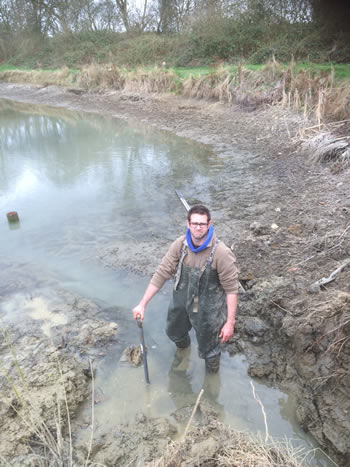Silt Control
 Decaying leaf litter causing foul smelling silt in the margins.
Decaying leaf litter causing foul smelling silt in the margins.Silt is a build up of decaying organic matter that is deposited on the bottom of a water body. If left unmanaged it will build year on year and over time cause a reduction in overall water depth and have huge negative effects on the productivity of your fishery.
A common problem we face is fishery owners struggling with excessive amounts of silt in their lakes. Lakes and ponds that are heavily tree lined are especially prone to heavy siltation as all the leaves that litter the lake in autumn eventually sink and decay on the lake bed causing a new layer of nasty smelling black silt every year.
 Hydrated lime on a fully drained pond works wonders for sterilising the pond and helping with silt.
Hydrated lime on a fully drained pond works wonders for sterilising the pond and helping with silt.If the water you manage or own is heavily tree lined then there is a strong possibility that your silt contains a high organic load (decaying leaf litter, fish waste etc). In this situation a product called Siltex is a great option. Siltex is a highly porous form of calcium carbonate that is environmentally friendly, harmless to fish, plants and all other aquatic inhabitants. The application of Siltex helps breakdown the organic matter and reduce harmful gasses within the silt layers. It counteracts the acidity of the water and provides a source of calcium which in turn increases biodiversity and the overall productivity of the water body.
You can use it as a one off application but works far better if incorporated into a yearly management plan.
 Installing a drain on a stock pond.
Installing a drain on a stock pond.Inlets are another source of silt and bring sediment in from upstream that settles and eventually causes a build up of silt. This non organic matter (sand and tiny gravel particles etc) can be much more difficult to deal with and Siltex will not be as effective on this type of silt as it cannot be broken down by the micro-organisms it creates.
If you have very high levels of this silt that is affecting the water body then a full drain down of the lake and manual removal may be the only option. This is where it can get extremely expensive as disposing of silt off site is a costly operation. There are some scenarios where it can be utilised on site so don’t write it off before all the options are explored. Settlement ponds and ‘monk type’ inflows constructed on the inlets of a water can be a great way to trap the sediment before it enters the water body and has chance to settle and build. This is a great way to prevent costly dredging or pumping and keeps year maintenance to a minimum.
When it comes to silt management prevention is key!
